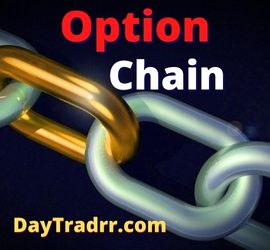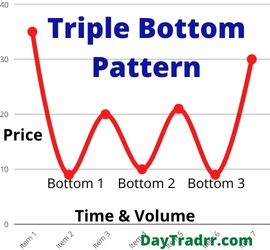What Is an Option Chain?
 An option chain is a list of all available option contracts for a particular stock or security. The information is quoted in a matrix table called a chain sheet. An option chain lists all the possible options contracts for a specific stock or investment. It displays all listed puts and calls, as well as their expiration dates, strike prices, volume, and pricing statistics. The information is provided for a specified underlying asset over a range of maturity periods. Typically, the chain is classified by expiration date and divided into calls and puts. An options chain contains detailed quotation and price information. It is distinct from an options series or cycle, which just indicates the available strike prices or expiration dates.
An option chain is a list of all available option contracts for a particular stock or security. The information is quoted in a matrix table called a chain sheet. An option chain lists all the possible options contracts for a specific stock or investment. It displays all listed puts and calls, as well as their expiration dates, strike prices, volume, and pricing statistics. The information is provided for a specified underlying asset over a range of maturity periods. Typically, the chain is classified by expiration date and divided into calls and puts. An options chain contains detailed quotation and price information. It is distinct from an options series or cycle, which just indicates the available strike prices or expiration dates.
An option chain may appear to be rows of random numbers at first glance. However, the chain sheet contains vital information about the stock or security. Not only its present value but where it may trend in the future. Options are not available for all publicly traded stocks. However, for those that are, the information is given in real-time and in a consistent order. Learning to decipher an option chain can help investors become more informed. Ultimately, this can mean the difference between making or losing money in the options markets.
Option Chain Explained
An option chain is a visual representation of a variety of information that can be useful while trading options. Options are contracts that grant the owner the right to buy (in the case of a call option) or sell (in the case of a put option) an asset at a predetermined price until a specific date. An option chain shows investors all possible option contracts, both puts, and calls, for a particular underlying security. Moreover, it displays strike prices and pricing information for a single underlying asset over a specified time frame. The display connects all of the information in the shape of a chain – hence the term option chain or matrix.
An option chain is perhaps the most natural way for ordinary investors to receive information. The option quotes are provided in an easy-to-follow order. Option premiums can be found by following the corresponding maturity dates and strike prices. Depending on how the data is presented, bid-ask quotes or mid-quotes are also visible within the information table. The majority of online brokers and stock trading systems present option quotes in an option chain format. Generally, the information is based on real-time or very slightly delayed data. The chain display makes it easy to scan activity, open interest, and price movements. Traders can focus on the individual options needed to meet a given options strategy.
For example, traders may quickly scan an asset’s trading activity. This includes frequency, volume, and interest by strike price and maturity months. Data can be sorted by expiration date, from earliest to latest. It can be further filtered by strike price, from lowest to highest.
Decoding the Option Chain Matrix
The data available in an options matrix are relatively self-explanatory. Traders focus on four columns of information to judge current market circumstances. Last Price, Net Change, Bid, and Ask are the columns. An experienced user can quickly comprehend the market in terms of price movements. For example, where high and low liquidity levels occur. This is crucial information for efficient trade execution and profitability. Only at the end of each trading day do market makers publish the information displayed in the option chain. The option chain matrix will be most beneficial on the following trading day.
Calls and Puts
Options chains are divided into two categories: calls and puts. A call option gives you the right (but not the duty) to buy 100 shares of stock at a specific price until a specific date. A put option also grants you the right (but not the responsibility) to sell 100 shares at a specific price up to a specific date. The call option is always listed first in an options matrix.
Expiration Date
Options have different expiration dates. For example, you could purchase a call option on a stock that expires in April or another that expires in July. Options with less than 30 days to expiry will lose value quickly because there is less time to execute them. Columns in an option chain are listed in the following order: strike, symbol, last, change, bid, ask, volume, and open interest. Each option contract, like the underlying stock, has its own symbol. Options contracts with multiple expiry dates on the same stock have different options symbols.
Strike Price
The strike price is the price at which you can buy (through a call) or sell (with a put). Call options with higher strike prices are usually less expensive than call options with lower strike prices. Lower strike prices translate into lower option prices for put options, and vice versa. To be executed, options require the market price to exceed the strike price. For example, if a stock is now trading at $50.00 per share and you purchase a call option for $65, the option is worthless until the market price exceeds $65.
Premium
The most recent posted trade is the latest price. The change column displays how much the last trade differed from the prior day’s closing price. Bid and ask prices represent the current prices at which buyers and sellers are willing to deal.
- Last – The last price column provides the most recent trade price that has been captured and published.
- Net Change – The information in the net change column shows the underlying asset’s direction (up, down, or flat) as well as the amount of price variance from the prior trade.
- Bid – The bid column shows how much a trader may expect to receive on the sale of that option within that time frame.
- Ask – The ask column contains information on how much the trader can expect to pay to purchase that option at that listed time frame.
- Trading volume – This is the number of contracts that change hands on a particular day, reflecting how liquid a certain option is.
- Open interest – This represents the total number of options outstanding on each strike and maturity, allowing you to gauge market commitment. The true degree of open interest fluctuates throughout the day.
Finding Option Chain Information
Most financial websites that include stock prices have real-time option chains. For example, Yahoo Finance, The Wall Street Journal Internet. Another source is online trading platforms such as Charles Schwab and TD Ameritrade are among them. Most websites will provide a link to the relevant options chains if you find the chart of the underlying stock. Here is an example of the option chain in an easy-to-decipher format for Apple Inc. AAPL. This data is available courtesy of the Wall Street Journal.
Up Next: What Is Backup Withholding Tax?
 Backup withholding tax is an IRS requirement used to collect taxes on certain types of income payments that are not subject to regular tax withholding. Investors should know that backup withholding is a tax that is levied on investment income. The withholding is at an established tax rate – usually, 24-28%. It is applied as the investor withdraws the funds. Payers are obligated to withhold the tax on payments that are not subject to other withholding requirements. Backup withholding ensures that government tax-collecting agencies, such as the Internal Revenue Service (IRS) or the Canada Revenue Agency, get income taxes owed to them from the earnings of investors. The method is used to make sure the government collects taxes on income that an investor may otherwise spend before his or her tax bill comes due.
Backup withholding tax is an IRS requirement used to collect taxes on certain types of income payments that are not subject to regular tax withholding. Investors should know that backup withholding is a tax that is levied on investment income. The withholding is at an established tax rate – usually, 24-28%. It is applied as the investor withdraws the funds. Payers are obligated to withhold the tax on payments that are not subject to other withholding requirements. Backup withholding ensures that government tax-collecting agencies, such as the Internal Revenue Service (IRS) or the Canada Revenue Agency, get income taxes owed to them from the earnings of investors. The method is used to make sure the government collects taxes on income that an investor may otherwise spend before his or her tax bill comes due.
Backup withholding may also be used if an investor fails to meet the requirements for taxpayer-identification numbers (TIN). When an investor withdraws investment income, the amount stipulated by the backup withholding tax is transferred to the government. This provides the tax-collecting agency with the necessary monies instantly but leaves the investor with less short-term cash flow. If you are a taxpayer receiving certain types of income payments, the IRS requires the payer of these payments to report them.




